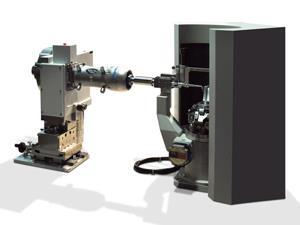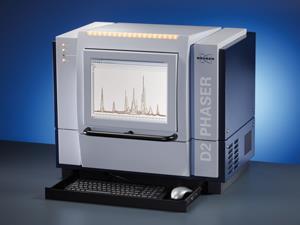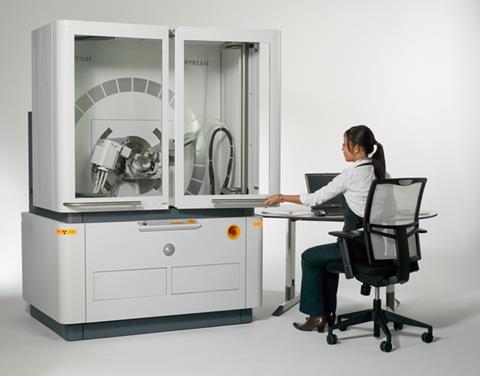From single crystals to powders and even proteins, there’s a diffractometer for every structure, as Elisabeth Jeffries discovers

It was not quite a sledgehammer cracking a nut. But scientists previously defeated by a chocolate imperfection in 2006 turned to the best beam they could find, the European synchrotron, to penetrate its essence. To understand why chocolate crystallises into a whitish bloom in hot weather, they needed to work out the crystal structure of this fatty substance. Based in Grenoble, France, the synchrotron is a stadium-sized machine producing x-ray light, one of 10 in Europe.
It is one of the brightest beams scientists employ to examine the most difficult and complex molecules using the extraordinary technique of crystallography. More commonly, they buy x-ray diffractometers to use in their own laboratories. The x-rays hit the sample, whose atoms scatter the beams. As a result of their regular atom arrangement, crystals scatter the rays in just a few specific directions. By measuring the direction and intensity of the scattered beams, scientists produce a three-dimensional picture of the crystal’s atomic structure.
The key diffractometer features are the strength and quality of the beam source and the detector – the component that monitors the diffracted beams. Major manufacturers thus differentiate themselves on the basis of these parts, as well as analytical software. They include Bruker, Agilent, Rigaku and Panalytical among many others. German company Marresearch sells mainly to users of protein crystallography. Products range from high-end powerful machines taller than a human being to benchtop products.
Watching the detectors
Detectors play an important role. Area detectors, introduced in the 1970s, accelerated the rate of research because the detectors measure an area rather than a single point. Most detectors are silicon devices. One of Bruker’s distinguishing features is its unusual detector, made from a complementary metal-oxide semiconductor (CMOS), part of a new generation.
‘For single crystal applications we have built in a CMOS active pixel detector. It has large pixel volumes, can collect more data and allows you to get a better resolution because it has a smaller pixel size – so it better resolves reflections which are closer together,’ says Rob Hill, Bruker UK sales manager. CMOS devices are also used in digital cameras.
Other emerging diffractometers use Pilatus detectors, a similar solid state detector technology originating from the Swiss Light Source, a synchrotron at the Paul Scherrer Institute. ‘These are the next generation of x-ray detector,’ says Simon Coles, director of the UK National Crystallography Service at Southampton University. ‘There is no background noise and it can’t be blasted or overloaded with one signal.’
Detection capacity is improved through shutterless data collection, one of the factors increasing the throughput of beam lines. Coles suggests solid state detectors could speed up results tenfold. Bruker’s decision to use a different kind of innovative solid state detector in one of its products, the Metaljet, indicates a perhaps distinctive market positioning.
‘The CMOS detector is less widespread. The issue is not one of cost but of integrating it in off-the-shelf systems. Industrial laboratories use diffractometers more as a day-to-day machine and want it to work off-the-shelf. It’s taken a while to integrate this into an everyday instrument,’ says Coles. However, Rigaku produced its first unified product fitted with a Pilatus detector in 2013, following Bruker’s CMOS launch in the same year.
Building the beam
The beam source and its impact on the sample are also critical. The beam source is captured using either sealed tube or rotating anode technology. In some cases, the x-ray is also focused using mirrors. Rotating anodes are the more recent development, but sealed tubes are cheaper and easier to maintain. ‘Rotating anodes are much stronger and produce an order of magnitude greater x-ray,’ says Coles. Bruker again differentiates itself with an unusual feature in its Metaljet system. The thinking behind this product is partly to divert an increasing flow of samples away from synchrotron and back to the home laboratory, especially in the life sciences. This is a concern most producers want to resolve to satisfy this market segment in particular.
‘The [lab x-ray] equipment sits idle 99% of time because we use the [UK synchrotron] Diamond Light Source instead. A lot of labs have got rid of it. This may be more for protein crystallography than for small molecules. It’s an expense and it’s time-consuming to look after it,’ says David Lawson, a scientist at the John Innes Centre in Norwich, UK.
X-ray sources are a big differentiator
Rotating anodes heat up during use. ‘In a normal x-ray tube, you rotate the anode so that you’re not hitting the same place all the time. Water is also used to cool the anode,’ explains Hill. However, Bruker’s Metaljet source integrates a gallium alloy to produce a liquid anode at room temperature, so that overheating is less of a concern. ‘There is a high x-ray intensity. Using this product, you can analyse samples which don’t diffract very well in the lab rather than go to a synchrotron. So you can get greater intensity. This is good for research on proteins,’ he says.
But Coles points out that this product is, so far, fairly specialised. ‘It’s a minor part of the picture in terms of what’s out there. A liquid gallium target is emergent, and not so popular. It dissipates heat, but uptake is slow, and it’s left-field technology,’ he comments.
A less experimental but widespread range of instruments is supplied by the manufacturer Agilent. Coles describes Agilent as ‘more middle-of-the-road’. The company uses well-established technology, such as sealed tubes. ‘They are not using rotating anodes nor solid state detectors. Their core product is very good. They have the main market share at the moment,’ he says.
Japanese manufacturer Rigaku provides a full range of products, including some with more unusual and cutting-edge features. ‘X-ray sources are … a big differentiator. Rigaku has been making rotating anode x-ray generators for a long time, as well as making sealed tube and microfocus sealed tube x-ray sources,’ says Paul Swepston, the company’s chief marketing officer. He claims this combination of advanced techniques and product breadth is one of the explanations for the high output of laboratories that use their instruments.
‘The high powered x-ray sources are important for difficult samples, and two of our installations in the UK, Southampton and St Andrews, use Rigaku’s rotating anode based systems, which enable them both to be among the most prolific x-ray facilities in the world,’ he says.
Coles confirms he purchased a whole suite of Rigaku products during a £1.8 million buying spree in 2011. ‘We canvassed all the manufacturers but Rigaku gave the best response so we shifted to them. They are particularly strong on the high-end hardware. Most manufacturers have no comparable product but Rigaku outstripped Bruker on performance … the sheer power of their x-rays puts them in a whole different league,’ he says. However, he indicates their detectors are one possible relative weakness. Any major customer, however, will be able to negotiate special deals or features with most market leaders.
Rigaku is among the producers to also continue drawing on an older detector technique, the imaging plate, which can be found in its Rapid series of products. ‘This uses a large imaging plate, which essentially is large piece of reusable film. This system can double as a single crystal diffractometer as well as a powder diffractometer,’ says Swepston.
The technique first emerged in the 1980s but still offers some advantages. ‘It wraps around the whole crystal and is flexible for measuring a large portion of the diffraction space. It is not as sensitive as some of the modern electronic detectors, but there’s also no electronic noise. It is totally mechanical so very easy to fix and is very serviceable,’ says Swepston.

At the other end of the scale, benchtop products are becoming more popular. Bruker and Rigaku, for example, both produce benchtop instruments. Bruker’s benchtop powder diffractometer, known as the D2 Phaser, has been reduced to about the size of a microwave oven, costs £70,000 and weighs 95kg.
According to Hill, it has opened up new market segments. ‘It still produces high quality data, and uses a fast, accurate silicon strip detector. We’ve had huge numbers of extra orders for these powder diffractometers. Teaching labs and small pharmaceutical companies couldn’t use these techniques before,’ he says.
Powders and proteins
Powder diffractometers are sold by a number of producers, but Dutch manufacturer Panalytical is a market leader. Martijn Fransen, its product marketing manager, explains they can be used on solid materials too, such as metals and rocks. ‘Metals may be small crystalline domains solidified to each other. In solid materials there are often many crystals with a different orientation. But the main application is to look at mixtures of different crystals,’ he says. As a result, it is used in a wide range of industries, from mining to LED production. Less preparation is needed than for single crystal techniques, because there is no need to grow a crystal.

Panalytical makes a great show of its ‘Swiss army knife’ powder diffractometer, the Empyrean – a device for the high end of the market. The analogy alludes to the modularity and versatility of the product, which is sold as a platform technology. The cost ranges from £110,000–500,000 depending on functions selected by the customer. ‘Researchers using the Empyrean can do additional analysis without turning to another dedicated instrument. That can be a waste of money … we are expanding those additional applications continuously,’ says Fransen.
Modularity is a benefit many producers, such as Bruker, are aiming to improve. ‘As the instruments have become faster and more accessible, they can work as an additional product to go with nuclear magnetic resonance (NMR) and so on. We encourage people to use more than one technique,’ says Hill. As the demands and sophistication of laboratories increases, complementary techniques are likely to be in greater demand.
The increasing complexity of compounds studied, especially in chemistry, may well drive this and further advances in diffractometers, although it is also true that the technology drives the research, of course. ‘Chemists are working with smaller molecules and more complicated systems containing thousands of atoms rather than 20–30 previously. This can make getting decent data sets quite tough,’ says Coles. Research on materials for hydrogen storage, gas sieves and LEDs are examples of this complexity.
The demands of researchers working on often difficult protein molecules are also increasing, as indicated at the John Innes laboratory. As a result, instrument makers are developing instruments designed towards screening molecules before exposing them to the expensive synchrotron. ‘If you have dozens of crystals, you can extrapolate how they will diffract and identify the suitable candidates for the synchrotron so as not to waste time,’ says Hill. Continual IT advances also help fulfil this need.
‘From a technical point of view, an important criterion for choosing a small-molecule single crystal x-ray diffraction system is its ability to measure the diffraction data from small or weakly scattering crystals. From a more practical but no less important perspective, the ease of use of the controlling and processing software and the overall reliability of the equipment are also big factors,’ says Royston Copley, a senior investigator at pharmaceutical company Glaxo SmithKline.
Coles confirms the importance of software. ‘Setting up the instrument to collect the data is not that difficult. It’s taking the raw data and turning it into something you can work up – that is key. Crystals don’t always behave themselves – they may mould together. The more complex the chemical system, the more the demands from diffraction. The software has to be able to deal with complex, sometimes fuzzy, multiple patterns,’ he says. He suggests dynamic technology is the way forward, in which scientists play with questions about the crystal, such as whether it absorbs a gas. In this very productive field, further creativity can be expected.
Elisabeth Jeffries is a science writer based in London, UK












No comments yet